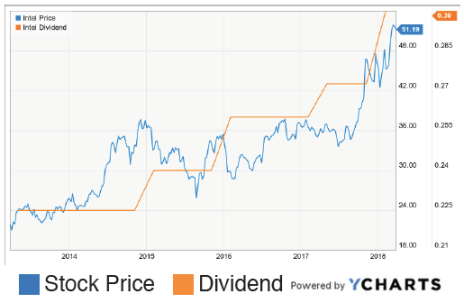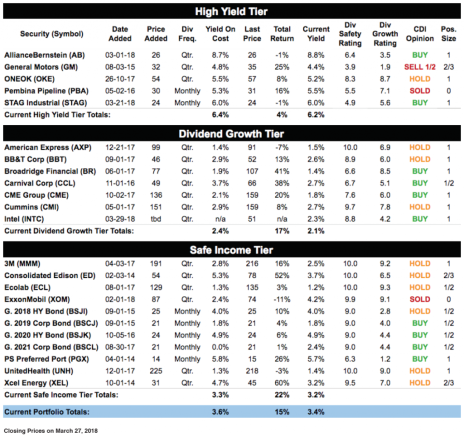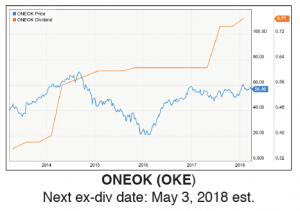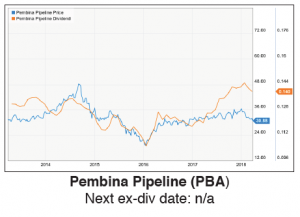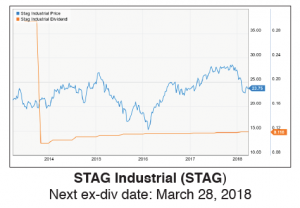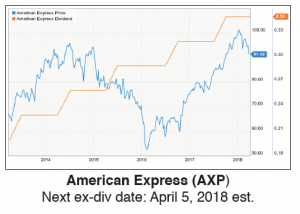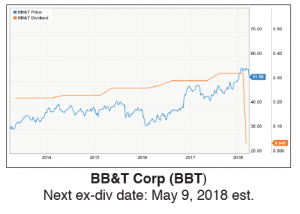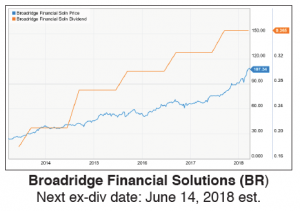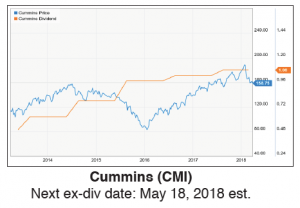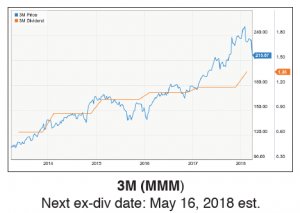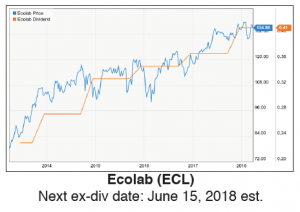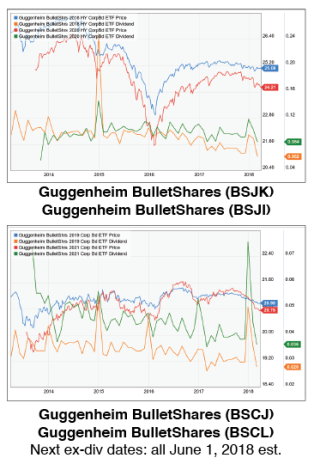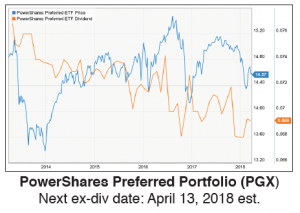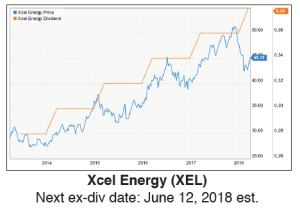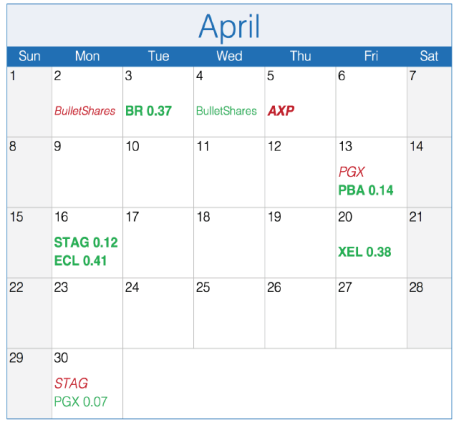Market action has gotten hairy, but it’s no reason to panic. In today’s issue I suggest some defensive moves, plus I have a new, nearly-bulletproof recommendation for dividend growth investors.
Cabot Dividend Investor 318
[premium_html_toc post_id="147254"]
A Garden-Variety Correction ... Probably
After developing some cracks earlier this month, the broad market rolled over last week; the major indexes all closed the week down over 5%. The S&P 500 closed just a few points above its February low, while the Dow hit a new year-to-date low. Monday brought a nice rebound, but the market gave back all the gains on Tuesday.
The intermediate trend is now down, according to Cabot’s market timing indicators. However, the long-term trend remains up, so it’s still likely that the market will find support and resume its uptrend—instead of keeling over. Regardless, it’s still wise to reduce risk a bit today; details of our moves are below.
Things have gotten equally eventful on the income investing side of things. Wednesday’s Fed rate hike and statement didn’t bring any surprises, (they did pencil in an additional hike in 2019), but treasuries and related securities have seen some readjustments anyway. Most significantly, long-term bond yields have declined. Reasons include a flight to safety triggered by the stock market volatility and a decrease in long-term inflation expectations. The move triggered readjustments in a number of markets, including a big selloff in financials.
[highlight_box]What To Do Now: Even though I think this pullback is more likely to be a garden-variety correction than the end of the bull market, it’s still wise to pull in your horns while it runs its course. That means you should tighten up your portfolio by selling laggards, maybe take some profits, and only buy stocks that are still healthy—and then in moderation. We’re adding one of those resilient leaders to the Dividend Growth tier today.
On the defensive side, today I’m selling another half of our General Motors (GM) shares and placing UnitedHealth Group (UNH) on Hold. I already switched BB&T (BBT) and 3M (MMM) to Hold in Monday’s special bulletin, and last week, I replaced High Yield tier laggard Pembina Pipeline (PBA) with STAG Industrial (STAG). If you missed the recommendation, flip back to your March 21 Cabot Dividend Investor update for a quick intro to STAG. [/highlight_box]
Featured Buy
Intel (INTC)
While many tech stocks have rolled over in recent weeks, there’s one dividend-paying member of the sector that has barely budged. The stock has also largely ignored the tariff panic, despite doing plenty of business with China, and last week’s market plunge.
Those are signs of a strong stock—one that will hold up well even if the market rolls over, or that could be a leader if the market gets going instead. So, with an eye to the future—whatever it may bring—I’m adding Intel (INTC) to the Dividend Growth tier today.
The Company
Founded in California in 1968, Intel makes processors, the hardware computers use for their most important tasks. Long the dominant supplier of processors for desktop computers, Intel struggled to adapt its technology for mobile devices. It showed: Intel’s earnings stagnated in 2011, and the stock traded sideways from 2014 to 2017. Intel eventually abandoned the smartphone market to Apple, Qualcomm and Samsung in 2016.
That decision allowed the company to focus on improving its higher-end processors, which are used in servers, desktops and laptops. The research paid off last year, as Intel’s technology pulled decisively ahead of AMD’s—its primary competitor in those markets. Intel revealed a game-changing new desktop processor in October, and a few days later, INTC broke out to a new 10-year high.
Earnings reflected Intel’s re-found success as well: in 2017, the company reported 6% revenue growth, and stunning 28% EPS growth.
The future looks equally bright. Last week, an industry blog confirmed that Intel will release an eight-core processor later in 2018, further cementing its lead over AMD. At the same time, Intel has continued to invest in new technologies like quantum computing and autonomous driving—the company acquired Mobileye, a leader in self-driving car technology, last year.
Analysts only expect EPS to rise 3% this year, but that’s expected to accelerate to 7% growth in 2019, and 9% growth over the next five years. Accelerating earnings growth is one of the best predictors of a rising stock price.
The Dividend
Intel pays dividends quarterly and currently yields 2.3%, one of the higher yields in the tech sector. Intel has paid dividends since 1992, and the dividend has been rising—albeit gradually—since 2003. Over the past five years, Intel’s dividend increases have averaged only 5.9%, but they’ve gotten bigger recently, and in January, Intel increased the dividend 10%, to $1.20 per year. And there’s more room for growth because the company’s payout ratio is only 34%.
All in all, Intel earns a strong Dividend Safety Rating of 8.8 and a lower—but rising—Dividend Growth Rating of 4.2.
The Stock
In October, Intel broke out past 40 for the first time in 10 years (the stock had made attempts at the level in 2014, 2016 and 2017 but was consistently rebuffed.) That breakout was followed by a quick run to 47, and then a slower, three-month climb above 50, where the stock sits now.
INTC is now above its 50- and 200-day moving averages, and in a choppy but definite uptrend. And the stock has had numerous opportunities to demonstrate its resilience recently. First in January, when news broke of a security vulnerability affecting all Intel chips (the company issued a patch and the weakness isn’t present in new chips) and then again last week, when the market tanked—without Intel, which remains just a hair below 10-year highs.
While there’s no sure thing in the stock market, Intel looks pretty bulletproof these days, and that’s the kind of stock we want in our portfolio right now. I’ll be adding 2.3%-yielding INTC to the Dividend Growth tier at tomorrow’s average price.
| Intel (INTC) | ||
|---|---|---|
| Price: 51 52-week range: 33.23-53.78 Market cap: $239.57 billion P/E: 26 | Current yield: 2.3% Annual dividend: $1.20 Most recent dividend: $0.30 Dividend Safety rating: 8.8 Dividend Growth rating: 4.2 | |
| Dividends since: 1992 Consecutive years of increases: 3 Qualified dividends? Yes | Payment Schedule: Quarterly Next ex-dividend date: May 4, 2018 | |
Portfolio at a Glance
Portfolio Updates
High Yield Tier
The investments in our High Yield tier have been chosen for their high current payouts. These ?investments will often be riskier or have less capital appreciation potential than those in our other ?two tiers, but they’re appropriate for investors who want to generate maximum income from their? portfolios right now.
BUY – AllianceBernstein (AB 26 – yield 8.8%) – AB is right where we left it last week, which is good, considering the week the market’s had. The stock’s short-term momentum is sideways, but longer-term its choppy uptrend remains intact. The asset manager remains a decent buy for investors whose priority is high income, and for whom predictability isn’t essential (AB’s distributions vary based on cash flow). AB is organized as a partnership, so dividends aren’t qualified and they issue a K-1 at tax time.
SELL 1/2 – General Motors (GM 35 – yield 4.4%) – GM had another lousy week, falling all the way to its August low. It’s still possible—even likely—that the stock could find support here, or down around 32.50. But the downtrend has become persistent: GM has been below its 50- and 200-day moving averages since the start of the month. In addition, earnings are expected to decline slightly this year, and analysts are concerned about slowing sales, tariffs and stiffer oversight of self-driving car technology. Given the market weakness, we’re going to reduce risk by selling another half of our shares today, leaving us with a third of our initial position. We added GM to the portfolio around 32, so we’ll book a profit of about 14%.
HOLD – ONEOK (OKE 57 – yield 5.2%) – OKE continues to trade around its 50-day line. The stock’s trend is mostly sideways, but it’s a solid holding for investors whose priority is high yield. The company owns 38,000 miles of natural gas and natural gas liquids (NGL) pipelines, as well as natural gas and NGL storage, processing and fractionation facilities (fractionation is the breaking down of NGLs into component liquids like ethane and propane.) ONEOK has increased its dividend every year since 2003, and last year’s dividend coverage ratio was a very comfortable 1.3x.
SOLD – Pembina Pipeline (PBA 31 – yield 5.5%) – I sold PBA last week and replaced it with STAG Industrial (STAG), which also pays monthly dividends and yields slightly more. We sold at Wednesday’s average price of $31.60 for a price-only profit of 6% and a 16% total return. Pembina’s dividends remain reliable, but the stock is going nowhere, so I recommend switching to STAG Industrial, profiled below.
BUY – STAG Industrial (STAG 24 – yield 6.0%) – STAG Industrial was added to our High Yield tier at last Wednesday’s average price of $23.74. STAG is a REIT (real estate investment trust) that owns industrial real estate—mostly warehouses, which are in high demand from e-commerce companies competing to ship faster and faster. Funds from operations (or FFO, a widely-used measure of REIT cash flow) have increased every year since the REIT came public in 2011. Last year, adjusted FFO increased by 29% (see the last page for more on FFO). Most importantly, the REIT pays monthly dividends, payments are steady (though they don’t qualify for the lower dividend tax rate) and the stock’s payout ratio is reasonable for a REIT (84% based on FFO). STAG just completed a 20% correction as interest rates surged, eventually finding support in early February. That’s a big drawdown (risk is always higher with high-yield stocks) but presents a good buying opportunity for us. It also defined a nice support level around 22.50 to watch should things go South. Investors with high risk tolerance looking for high monthly income can Buy some STAG here.
Dividend Growth Tier
To be chosen for the Dividend Growth tier, investments must have a strong history of dividend increases and indicate both good potential for and high prioritization of continued dividend growth.
HOLD – American Express (AXP 91 – yield 1.5%) – AXP dipped to touch its 200-day moving average again this week, echoing its pullback in February. The stock is still above those lows, and the 200-day is a probable place for another bounce, but if you’re looking to reduce risk, you could cut back a little here. On the plus side, earnings estimates remain strong, and Amex has paid dividends without interruption since 1977. While the short-term is a little murky, I’ll continue to Hold for medium- and long-term gains.
HOLD – BB&T Corp (BBT 52 – yield 2.9%) – BBT got whacked by a big financial sector selloff last week. The trigger was the decline in long-term bond yields, which flattens the yield curve and depresses profits at banks. A rotation out of “risk-on” assets and year-to-date outperformers may also have contributed. BBT slid over 7% before bouncing slightly this week. The stock is now definitively below its 50-day, and almost even with its February low. It’s not a pretty technical picture, but volume wasn’t especially elevated and the stock is still well above its 200-day, which is down at 49. I’ll keep BBT on Hold for Dividend Growth investors. (Note that the big drop in the dividend line on the chart reflects the special 45-cent dividend BBT paid on top of its last quarterly dividend.)
BUY – Broadridge Financial Solutions (BR 107 – yield 1.4%) – BR barely budged this week, and remains near all-time highs. Our only concern is that our profit is getting big (40% on price alone) and the stock is a little overextended—about 8% above its 50-day line. But it’s held up so well over the past week that there’s no real reason to sell now. Do wait for a pullback before buying though.
BUY – Carnival (CCL 66 – yield 2.7%) – Carnival (whose fiscal year starts in December) reported first-quarter 2018 earnings that easily beat estimates Thursday. The stock opened higher but was dragged down by the broad market selloff. CCL has begun to rebound this week, and remains within its six-month trading range. The cruise company’s first-quarter report showed that demand for cruises remains high; bookings and prices are both running ahead of last year. Carnival even managed to improve margins slightly, despite rising fuel costs. Analysts have revised their estimates upward following the latest results, and EPS are now expected to rise 15% this year. CCL remains range-bound, but I still think the stock’s next significant move will be up, and am keeping it on Buy for dividend growth investors.
BUY – CME Group (CME 159 – yield 1.8%) – CME has pulled back to its 50-day moving average, presenting a nice buying opportunity for dividend growth investors. Renewed market volatility should, ultimately, be a good thing for CME Group, since it stokes trading on their exchanges. Reportedly, the company is considering acquiring NEX group, which would add currencies, Treasuries and more to the already broad range of securities traded on CME exchanges. Buy on pullbacks for dividend growth and generous annual special dividends.
HOLD – Cummins (CMI 159 – yield 2.9%) – CMI continues to trade sideways, and didn’t see much of a bounce Monday (but it didn’t see a lot of selling last week either.) The engine maker could be hit by tariffs on steel and aluminum, and its long-term uptrend is looking shakier the longer it takes to recover. But earnings estimates have been rising, and remain strong. We’ll Hold for now, but could sell half our shares if the market environment worsens.
Safe Income Tier
The Safe Income tier of our portfolio holds long-term positions in high-quality stocks and other investments that generate steady income with minimal volatility and low risk. These positions are appropriate for all investors, but are meant to be held for the long term, primarily for income—don’t buy these thinking you’ll double your money in a year.
HOLD – 3M (MMM 216 – yield 2.5%) – Last week’s big selloff in industrial stocks, triggered by more tariff talk, dragged MMM below its 200-day for the first time since November 2016. The stock is now at its lowest price since October. The U.S. and China may now be working things out though, so we’ll give 3M a chance to recover. Hold for now.
HOLD – Consolidated Edison (ED 78 – yield 3.7%) – ConEd is a New York-area electric utility with slowly rising earnings and a very reliable dividend. Increased panic and a “risk-off” rotation into conservative names are translating into strength in utilities, bolstered by falling long-term bond yields. ED is no exception, and is actually back above its 50-day this week for the first time since December. Hold for slowly rising income.
HOLD – Ecolab (ECL 135 – yield 1.2%) – ECL remains in the higher range where it traded in December and January, and above its 50- and 200-day moving averages. EPS estimates for the chemical company are rising, and the stock could earn back its buy rating soon. For now, stolid ECL is a good safe income holding in this environment.
HOLD – Guggenheim BulletShares 2018 High Yield Corporate Bond ETF (BSJI 25 – yield 4.0%)
BUY – Guggenheim BulletShares 2019 Corporate Bond ETF (BSCJ 21 – yield 1.8%)
BUY – Guggenheim BulletShares 2020 High Yield Corporate Bond ETF (BSJK 24 – yield 4.9%)
BUY – Guggenheim BulletShares 2021 Corporate Bond ETF (BSCL 21 – yield 2.4%)
Investors looking to get more conservative should consider a bond ladder, like our four-year ladder made up of BulletShares funds. A bond ladder is a conservative strategy for generating income by buying a series of individual bonds or defined-maturity bond funds that mature in successive years. Because the BulletShares funds mature at the end of the year in their name (at which point Guggenheim disburses the net asset value of the ETF back to investors), they are a good store of value even when interest rates rise. The longer-dated funds may pull back temporarily when rates rise, as we’ve seen with the 2021 fund over the past few months, but as long as you hold until maturity you can ignore the pullbacks. And if you reinvest the proceeds of the maturing fund in a new, longer-dated holding every year, you can secure rising income stream as rates rise. Guggenheim is in the process of selling the BulletShares and all their other ETFs to Invesco, but I don’t expect the change in ownership to change anything for BulletShares shareholders. The 2018 BulletShares fund is on Hold; it matures at the end of this year and its yield will gradually decline over the next 10 months as Guggenheim moves the fund into cash. So if you’d like to construct your own bond ladder today, start with BSCJ or its 2019 high yield counterpart, BSJJ.
BUY – PowerShares Preferred Portfolio (PGX 15 – yield 5.7%) – PGX is an ETF that holds preferred shares and pays dividends monthly, making it a good conservative holding for investors looking for regular income. The fund has low volatility but no capital appreciation potential; it generally trades between 14 and 16. Currently trading around 14.60, PGX is buyable now for investors looking for a good store of value and regular income.
HOLD – UnitedHealth Group (UNH 218 – yield 1.4%) – Last week’s tumble brought UNH down to its February lows, but it bounced just shy of its 200-day moving average. Support looks solid here, but I’m still going to move UNH to Hold until the market becomes more supportive and it can get back above its 50-day line. The company has an eight-year history of dividend growth, funded by a massive health insurance business and a growing medical services business.
HOLD – Xcel Energy (XEL 45 – yield 3.2%) – Like ED, XEL is back above its 50-day for the first time since December thanks to the rebound in utilities. Investors whose primary goal is income can continue to Hold. XEL is a Minnesota-based utility, the largest producer of wind energy in the U.S., and has a highly reliable income stream. The utility recently increased its dividend by 5.6%, the 14th consecutive annual increase in a row.
Closing Prices on March 27, 2018
Dividend Calendar
Ex-Dividend Dates are in RED and italics. Dividend Payments Dates are in GREEN. Confirmed dates are in bold, all other dates are estimated. See the Guide to Cabot Dividend Investor for an explanation of how dates estimated.
Important Information for REIT Investors
Last week I added a new real estate investment trust, or REIT, to the High Yield tier. REITs can be a great source of high income, but they have some unique features that investors should be aware of.
To start with the basics, real estate investment trusts are special purpose entities, with special tax status, that own real estate and pass along most of the income from the real estate (rents or mortgage payments) to shareholders. They can own any type of real estate, and many specialize in one type. Our new addition, STAG Industrial (STAG) owns industrial buildings, like manufacturing facilities and warehouses. It’s what’s known as an Equity REIT, because it owns property directly and gets most of its income from rents. There are also mortgage REITs, which own mortgages and mortgage-backed securities—they’re much more leveraged to credit conditions and interest rates and I don’t recommend any at this time.
Both types of REITs are exempt from taxation at the trust level as long as they pay out at least 90% of their income to investors. That means that while any retained income will be subject to regular corporate-rate taxes, the REIT doesn’t have to pay taxes on current income (rents or interest payments from the current period) that is distributed to shareholders. Essentially, the REIT is treated as a “pass through” entity, collecting the rents or interest payments and then passing them on to investors. It’s as if you own a sliver of the properties or mortgages themselves.
That’s why we analyze REIT earnings a little differently. As income investors, we don’t really care about the REIT’s retained income or EPS. The important number to us is how much cash the REIT generates and can distribute to investors. You can get an idea of this by looking at a REIT’s Net Income, a GAAP number reported with quarterly earnings which equals revenues minus expenses. However, NAREIT (the National Association of REITs) has developed an industry-standard but non-GAAP measure that can give us an even better idea of how the REIT is really doing.
That number is Funds From Operations, or FFO. FFO is calculated by adding real estate depreciation back to net income (see box), and then subtracting gains from the sale of real estate (which generate non-recurring revenue). The result is a good indication of how much cash the REIT’s regular income sources—leases or mortgages—generate on an ongoing basis.
STAG also reports core FFO, which strips out some one-time expenses like property acquisition costs. Some REITs go further, ignoring recurring capital expenses, like repairs and maintenance, and other items to calculate AFFO, or adjusted funds from operations. Whichever number the REIT uses, it should show cash flow more than covering distributions. For example, in the most recent quarter, STAG Industrial reported core FFO of $0.44 per share, and distributed $0.35 per share to investors.
The remainder of the REIT’s revenue can be used to improve their properties, acquire new properties, or for operating expenses. Most REITs also borrow heavily to make new acquisitions or improve properties. REITs are usually highly leveraged as a result, so high debt is not in itself a reason to stay away from a REIT, but you do want to make sure your REIT’s debt is manageable.
You can do this by looking at a measure like the debt to equity ratio and comparing it to the industry average and the REIT’s typical historical level, or by looking directly at the REIT’s outstanding debt obligations and maturities. STAG’s debt to equity ratio is currently 0.86, which is lower than it was 12 months ago, and lower than the industry average of 1.0.
REIT performance tends to be more correlated to the real estate market, interest rates and credit conditions than the rest of the equity market. Better-capitalized REITs should be more insulated from rising interest rates, but all REITs are susceptible to interest rate-related shocks. In the first two months of this year, interest rates climbed steadily, and Vanguard’s Real Estate ETF (VNQ), the most popular vehicle for owning REITs, fell 16% (STAG fell 12%).
Finally, owning REITs does have some tax consequences. Most of your REIT distributions will be classified as ordinary income, because you are treated as a part owner of the assets the REIT owns, and thus income from those assets is treated as your income. However, when some portion of a REIT’s distribution did not come directly from that quarter’s real estate ownership activities—for example, if it sold a building and distributed part of the proceeds to investors—you may be taxed differently on that portion of the distribution. The REIT will tell you after the year end how that year’s dividends should be treated. Options include ordinary income, qualified dividend income, long-term capital gains, and return of capital. Any portion of the distribution that is treated as return of capital will reduce your cost basis in the REIT, and then you’ll be taxed on the difference between your purchase price and your adjusted cost basis when you sell the REIT.
On average though, about 70% of REIT distributions are taxable as ordinary income. This makes REITs a good choice for tax-advantaged accounts like IRAs and 401(k)s and for investors with a low income tax rate.
[premium_html_footer]
Your next issue will be published April 25, 2018
Cabot Wealth Network • 176 North Street • Salem MA 01970 • 978-745-5532
Neither Cabot Wealth Network nor our employees are compensated by the companies whose stocks we recommend. Sources of information are believed to be reliable, but are in no way guaranteed to be complete or without error. Recommendations, opinions or suggestions are given with the understanding that subscribers acting on the information assume all risks. © Cabot Wealth Network. Copying and/or electronic transmission of this report is a violation of U.S. copyright law. For the protection of our subscribers, if copyright laws are violated, the subscription will be terminated. To subscribe or for information on our privacy policy, call 978-745-5532, visit www.cabotwealth.com or write to support@cabotwealth.com.
[/premium_html_footer]


